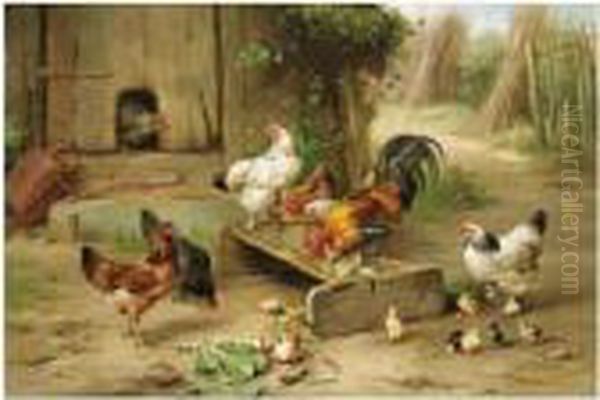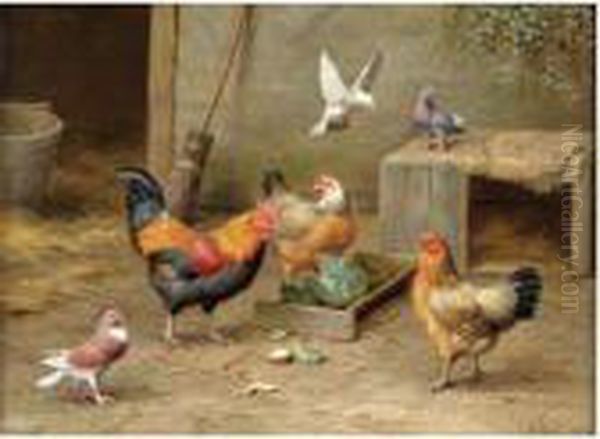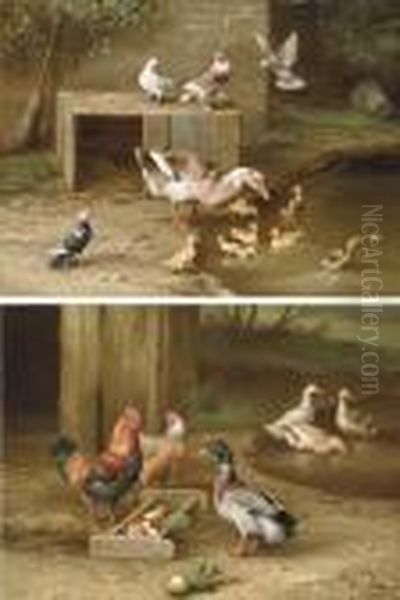An Introduction to the Artist
Edgar Hunt (1876-1953) stands as a significant figure in the tradition of British animal painting. A highly skilled artist operating primarily within the realm of Realism, Hunt dedicated his career to the meticulous and affectionate depiction of farm animals and the rustic charm of rural life. Born into an era transitioning from Victorian certainty to Edwardian change, Hunt carved a distinct niche for himself, becoming particularly renowned for his intimate portrayals of poultry, capturing the textures of feathers and the characteristic behaviours of his subjects with remarkable fidelity. His work continues to be appreciated for its technical proficiency, observational accuracy, and the gentle, pastoral atmosphere it evokes.
Early Life and Artistic Roots
Edgar Hunt was born in Birmingham, England, in 1876, into a family deeply immersed in the arts. His grandfather, Charles Hunt (1803-1877), was an engraver and painter known for sporting and coaching scenes. His father, Charles Hunt Jr. (1829-1900), was also an accomplished artist, specializing in genre scenes often featuring animals, carrying on the family's artistic inclinations. Furthermore, Edgar's brother, Walter Hunt (1861-1941), also became a painter, known for his depictions of farm animals and rural life, sharing a similar thematic focus with Edgar. This familial environment undoubtedly provided Edgar with his earliest exposure to artistic techniques and sensibilities.
Unlike many artists of his time who sought formal academic training, Edgar Hunt largely developed his skills under the guidance of his father. He did not attend the prestigious art academies in London or elsewhere. Instead, his artistic education was more practical and observational, rooted in the family studio and direct engagement with the subjects he would come to master. This hands-on approach, likely combined with an innate talent for detailed rendering, shaped his distinctive style.

A formative period in Hunt's youth involved spending time working on a farm in the county of Sussex, located in the south-east of England. This experience proved crucial for his artistic development. It allowed him prolonged, close observation of farm animals in their natural environment – their movements, interactions, anatomy, and the textures of their coats and feathers. This direct immersion provided him with an invaluable understanding of his subjects, far beyond what could be learned from sketches or secondary sources alone. This period cemented his lifelong fascination with farmyard life and provided the authentic foundation upon which his artistic reputation was built.
The Realistic Style of Edgar Hunt
Edgar Hunt's artistic style is firmly rooted in Realism. His primary objective was to render his subjects with a high degree of accuracy and detail, capturing the tangible reality of the farmyard. He possessed a remarkable ability to depict the varied textures found in his chosen scenes – the softness of downy chicks, the glossy sheen of rooster feathers, the rough texture of straw bedding, the weathered wood of barn doors, and the metallic glint of feeding pans. This meticulous attention to surface detail lends his paintings a convincing, almost photographic quality, yet they retain a painterly warmth.
Hunt's technique involved careful drawing and precise brushwork. He built up his compositions with layers of paint, ensuring anatomical correctness in his animals. Whether painting chickens, ducks, pigeons, rabbits, goats, or donkeys, he demonstrated a keen understanding of their physical structure. His use of light is often subtle but effective, typically depicting scenes within the soft, diffused light of a barn interior or the gentle sunlight of a farmyard setting. This careful handling of light and shadow enhances the three-dimensionality of his subjects and contributes to the overall tranquil atmosphere of his work.
While striving for realism, Hunt's paintings are not merely cold, objective studies. There is an undeniable affection and sensitivity in his portrayal of animals. He often focused on depicting creatures in quiet, intimate moments – feeding, resting, or tending to their young. This imbues his work with a sense of charm and gentle sentiment, appealing to a widespread appreciation for the perceived innocence and simplicity of rural life. His realism is thus tempered with a warmth that prevents it from becoming purely clinical documentation.
Themes and Beloved Subjects
The predominant theme throughout Edgar Hunt's oeuvre is the depiction of domestic farm animals within their typical settings. He rarely strayed from this subject matter, finding endless inspiration in the daily life of the farmyard. His focus was not on dramatic narratives or grand allegories, but rather on the quiet, everyday existence of the creatures he observed so closely. His paintings often present small groups of animals interacting naturally, creating vignettes of pastoral life.

Poultry were undoubtedly Hunt's most favoured and frequently recurring subjects. He painted chickens – roosters, hens, and chicks – with unparalleled frequency and skill. His detailed studies of different breeds, capturing their plumage, posture, and characteristic pecking and scratching behaviours, became his signature. Ducks, geese, and pigeons also featured prominently in his work, often depicted near water troughs or scattered feed. These birds allowed him to showcase his mastery of rendering feathers and capturing lively, small-scale interactions.
Beyond birds, Hunt also painted other common farm inhabitants. Rabbits and guinea pigs often appear, sometimes alongside poultry, adding variety to his compositions. Donkeys and goats feature in some works, usually portrayed with the same careful attention to detail and gentle characterization. Small ponies also occasionally make an appearance. The settings are typically rustic barn interiors, stable yards, or simple outdoor enclosures, often featuring elements like straw, wooden barrels, earthenware bowls, and simple farming implements, all rendered with the same meticulous care as the animals themselves.
Hunt's work tapped into a deep-seated appreciation for the countryside and animal life, particularly prevalent in Britain during the late 19th and early 20th centuries. As industrialization transformed the landscape and society, idealized images of rural tranquility and the natural world held significant appeal. Hunt's paintings offered viewers a glimpse into this seemingly simpler, more harmonious existence, focusing on the charm and inherent appeal of domestic animals. His consistent dedication to this theme secured his reputation as a leading specialist in the field.
Career, Exhibitions, and Recognition
While Edgar Hunt came from an artistic family and developed considerable skill, his career path was perhaps less public-facing than some of his contemporaries. He did exhibit his work, primarily at venues known for showing traditional and genre painting. Records indicate he showed paintings at the Royal Society of Artists, particularly its Birmingham branch (reflecting his origins), and also likely exhibited in London. The Walker Art Gallery in Liverpool, a major institution in the north of England, is also noted as a venue where his work was displayed, suggesting a reach beyond the Midlands and the capital.

His most productive and recognized period is often considered to be from the late 1890s through to around 1930. During these decades, he refined his style and produced a significant body of work focused on his preferred farmyard subjects. His paintings found a ready market, appealing to middle-class collectors who appreciated finely detailed, accessible, and sentimentally pleasing depictions of rural life. The demand for animal paintings, established by earlier artists, remained strong, and Hunt's specialization, particularly with poultry, made his work highly desirable within this niche.
Despite this market success, Hunt seems to have maintained a relatively private life, especially in his later years. Unlike artists who actively sought the limelight or engaged heavily with the politics of the art world, Hunt appeared more content to focus on his meticulous craft and his connection with the animals he painted. Sources suggest he was not driven by a desire for widespread fame or inclusion in the avant-garde movements of the time. His commitment was to his chosen genre and the perfection of his representational skills within it.
Consequently, while recognized and successful within his specific field during his lifetime, he may not have achieved the same level of broad public renown as some other artists. However, his work has endured, and he remains a highly respected name among collectors and enthusiasts of traditional British animal painting. His paintings continue to appear at auction, often commanding respectable prices, a testament to the lasting appeal of his skill and chosen subject matter.
Representative Works
Several paintings exemplify Edgar Hunt's style and thematic concerns. While specific exhibition histories for individual works can be elusive, titles recorded in auction results and collection databases give a clear picture of his output.
Farmyard Pets (c. 1900): This title encapsulates the essence of Hunt's work. Paintings under this or similar titles typically depict a mixed group of small farm animals – perhaps chickens, pigeons, and rabbits – coexisting peacefully in a barn or yard setting. These works highlight his skill in differentiating textures (feathers, fur, straw) and creating harmonious, detailed compositions.
Rooster, Rabbits and Guinea Pigs (1901): This specific title points to a common grouping in Hunt's work. The proud rooster, often depicted with vibrant plumage, would provide a focal point, contrasted with the softer forms and fur textures of the rabbits and guinea pigs. Such paintings showcase his ability to handle different animal anatomies and surface qualities within a single scene, usually set against a backdrop of straw and simple wooden structures.
Two Hens and Four Chicks in a Barn: This title represents Hunt's most iconic subject matter – poultry. Works like this focus on the maternal hen and her brood, a theme allowing for tender sentiment and the detailed rendering of downy chicks alongside the adult birds. The barn setting provides context and allows for Hunt's characteristic play of light in an interior space. Paintings with similar titles, varying the number of birds, form a significant part of his legacy.
Other typical titles found in records of his work include Chickens and Pigeons by a Dovecote, Donkeys and Goats in a Stable, Feeding Time, and numerous variations on hens, chicks, and roosters in farmyard settings. These works consistently demonstrate his meticulous realism, his focus on animal behaviour, and the peaceful, rustic atmosphere that defines his contribution to British art.
The Tradition of British Animal Painting
Edgar Hunt's work did not emerge in a vacuum; he was part of a long and distinguished tradition of animal painting in Britain. This genre had gained significant prominence by the 18th century, notably with the work of George Stubbs (1724-1806). Stubbs brought a new level of anatomical accuracy to animal depiction, particularly horses, based on rigorous study and dissection. His work set a high standard for realistic representation.
The 19th century saw the rise of Sir Edwin Landseer (1802-1873), perhaps the most famous British animal painter of the Victorian era. Landseer was celebrated for his technical skill but also for his ability to imbue animals with human-like emotions and narratives, often with a sentimental or moralizing undertone (e.g., The Monarch of the Glen, Dignity and Impudence). His immense popularity reflected the Victorian fondness for animals and narrative art. Hunt, in his focus on detailed realism and sometimes gentle sentiment, can be seen as working within a lineage influenced by Landseer, albeit typically on a more intimate, less grandiose scale.
Other notable animal painters preceded or were contemporary with Hunt. John Frederick Herring Sr. (1795-1865) and his son John Frederick Herring Jr. (1820-1907) were renowned for their paintings of horses, particularly racehorses and farm scenes. Thomas Sidney Cooper (1803-1902) specialized almost exclusively in pastoral landscapes featuring cattle and sheep, enjoying a remarkably long and successful career. William Huggins (1820-1884), based in Liverpool, was known for his detailed paintings of domestic and exotic animals. Briton Rivière (1840-1920) also gained fame for his animal subjects, often placed in narrative or historical contexts.
Edgar Hunt, along with his brother Walter Hunt, continued this tradition into the late 19th and early 20th centuries. They focused specifically on the domestic animals of the farmyard, bringing a high level of detailed realism to this niche. While Landseer might have aimed for grander statements, the Hunts excelled at capturing the quiet charm and specific character of common farm creatures. Edgar Hunt's particular mastery of poultry distinguished him even within this specialized field.
Hunt in the Context of Victorian and Edwardian Art
Edgar Hunt worked during a period of significant change and diversification in the British art world. The Victorian era, particularly its later decades, was dominated by the Royal Academy and its preference for narrative paintings, historical scenes, and polished realism. Artists like Lord Leighton, Sir Lawrence Alma-Tadema, and the aforementioned Landseer represented the establishment. However, challenges to this academic tradition were emerging.
The Pre-Raphaelite Brotherhood, though originating earlier, continued to exert influence through artists like John Everett Millais (in his later career) and Edward Burne-Jones, emphasizing detail, symbolism, and often literary or medieval themes – a different path from Hunt's straightforward realism. Social Realism also gained traction, with artists like Luke Fildes and Hubert von Herkomer depicting scenes of poverty and contemporary social issues, again distinct from Hunt's pastoral focus.
By the late 19th and early 20th centuries (the Edwardian period), the influence of French Impressionism and Post-Impressionism began to be felt more strongly in Britain. Artists associated with the New English Art Club, such as Walter Sickert and Philip Wilson Steer, explored effects of light, looser brushwork, and modern urban subjects, representing a move towards Modernism. The Arts and Crafts movement, led by figures like William Morris, emphasized craftsmanship and design, reacting against industrial production.
Within this complex landscape, Edgar Hunt remained firmly committed to a traditional, realistic approach focused on a specialized subject. He did not engage with the avant-garde trends or the grand social narratives of his time. His art represented a continuation of established genre painting, catering to a taste for meticulous craftsmanship and reassuring, familiar subject matter. His success indicates that despite the rise of modernism, there remained a strong market and appreciation for well-executed traditional realism, particularly depictions of the natural world and rural life. He occupied a specific, respected niche rather than positioning himself at the forefront of artistic innovation.
Critical Reception and Lasting Legacy
During his lifetime, Edgar Hunt achieved recognition and commercial success within his chosen field. His work was appreciated for its exceptional technical skill, the accuracy of his animal depictions, and the charming, peaceful atmosphere he consistently created. Critics and collectors alike admired his ability to render textures, particularly feathers, with such convincing detail. His paintings fulfilled a demand for high-quality, representational art focused on popular subjects like farm animals and rural scenes. The fact that he came from an established family of artists likely also aided his initial reception.
His adherence to realism and traditional subject matter meant he was unlikely to be lauded by critics championing modernist innovation. While his technical mastery was undeniable, his work might have been seen by some as repetitive or overly sentimental, lacking the intellectual depth or formal experimentation found in other contemporary art movements. The focus on small domestic animals, while popular with a certain audience, might have been considered less ambitious than historical, mythological, or socially conscious themes favoured by the Academy or the challenging perspectives offered by the avant-garde.
There is little evidence of major controversy surrounding Hunt's work. He operated within accepted conventions for his genre. Any "controversy" would likely stem from broader debates about the value of traditional realism versus modernism, or the perceived hierarchy of subject matter in art, rather than specific issues with Hunt's paintings themselves. His relatively private nature and focus on his craft meant he avoided the kind of public disputes or scandals that sometimes surrounded more provocative artists.
Today, Edgar Hunt's legacy rests on his status as one of the foremost British painters of farmyard animals, particularly poultry. His work is highly sought after by collectors of traditional British art and animal paintings. Auction results consistently demonstrate the enduring appeal and market value of his meticulously crafted scenes. He is remembered for his dedication to his specific subject, his exceptional observational skills, and his ability to capture the quiet charm of the farmyard with unparalleled detail and gentle affection. While not an innovator who changed the course of art history, he perfected a particular genre, leaving behind a body of work admired for its craftsmanship and timeless appeal.
Conclusion: A Dedicated Observer of Rural Life
Edgar Hunt carved a unique and enduring place for himself in British art history through his unwavering dedication to depicting the inhabitants of the farmyard. Born into an artistic lineage, he honed his skills through close observation and familial guidance rather than formal academic training. His realistic style, characterized by meticulous detail, textural accuracy, and sensitive handling of light, brought his subjects – especially his beloved poultry – to life on canvas.
Working within a strong British tradition of animal painting established by figures like Stubbs and Landseer, Hunt focused on the intimate and everyday aspects of rural life. While contemporary art explored modernism, social commentary, and abstraction, Hunt remained committed to his chosen genre, finding a receptive audience for his charming and skillfully executed works. He exhibited at established venues and enjoyed commercial success, yet maintained a relatively private persona.
Though perhaps viewed by some critics as lacking in grand ambition or innovation, the enduring appeal of Edgar Hunt's paintings speaks for itself. His work continues to be admired and collected for its technical brilliance, its affectionate portrayal of animals, and the tranquil, pastoral world it evokes. He remains a master of his specific niche, a testament to the value of dedicated observation and consummate craftsmanship in capturing the enduring beauty of the natural world.